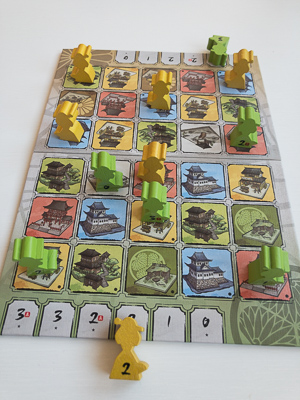

![[IMAGE]](../bilder/shadows1.jpg) |
Author: Publisher: No. of Players: |
![[IMAGE]](../technik/box/rot/rot-6.gif) ![[IMAGE]](../technik/box/gelb/gelb-8.gif) ![[IMAGE]](../technik/box/grun/grun-8.gif) ![[IMAGE]](../technik/box/pink/pink-7.gif) ![[IMAGE]](../technik/box/blau/blau-7.gif) |
|
G@mebox author Ralf Togler writes about the game:
In the middle of Europe we know comparatively little about the history of East Asia. This applies all the more for names of emperors, revolutionaries and generals. I must confess that I had to look up the name of Emperor Meiji, although he presided over a rapid time of change in Japan, changing the land from a feudal country to an industrial nation. But Meiji also had powerful opponents. Especially the Oniwaban group, a group of undercover spies, was a serious threat to the government. It was quite famous for their skilled female agents.
We in the gaming world are quite lucky, because a lot of games nowadays are set in historical backgrounds. And often the rules introduce us in part of the history of a foreign land. Thus we learn more about the history. This also applies to Shadows in Kyoto from the Taiwanese publisher EMPERORS4. The story is the fight between the Meiji government and the Oniwaban group, with the players' goal to find key intelligence about the opponent's spies, while on the same time protecting their own agents.
 Shadows in Kyoto is a pure two player game in which players have different ways to win the game. The main mechanic of the game is hand management, but the players' agents act on an area board, where they are moved and attack other players' agents. The board is a tiny 5x6 grid pattern of different coloured temples. Each player starts with five agents face to face to the opponent's spies in the first row of the board respectively. One more agent is placed one row further in the middle of the row. As a result, the players' pieces start facing their opponents like in chess. Now, in a normal move, a player simply chooses one of his agents, plays a card, and moves the agent one space towards his opponent to the site with the same colour of the card. From the point of view of your opponent, all agents seem to be alike. But the agents differ in power, ranging from 0-3. At the beginning of the game, these powers are still hidden. Now, if one agent moves in a site, where an enemy agent is present, there is a conflict and the powers of both spies are revealed by the attacker. The values are compared only by the attacker (so the defender will not automatically learn about the attacker's power). If the attacker has at least the same power as the defender, he is the winner and can capture the defender. But there is one exception: A power of 0 always beats a power of 3, a feature that makes a lot of bluffing strategies possible. If however the attacker had the minor power, he must retreat and is now in danger, because his opponent knows more about his power (but of course he still have to possess the right card to move into the region).  It is the player's aim to capture two of the enemies agents. But there is one more requirement: it must be agents with a real intelligence, marked by a small symbol next to the power. Of course, this symbol is hidden from the opponent as long as the agent hasn't been forced to reveal it. New players tend to send their agents with fake intelligence to the front, but you must be careful that your opponent will not figure out this strategy. If two of your agents are left alone in the back, it might be suspicious, and they could get in danger, because there is no way back for the moved up agents to protect them (agents must always move forward). You can see that there are a lot of bluffing elements and elements of area control in the game. Tactic cards and beautiful charisma cards of the female spies further expand the possibilities of the players. Tactic cards enable the players to perform moves that would be forbidden in the basic game. For example you can be allowed to move back or swap two of your agents. Even movements of your opponent's agents can be possible. Tactic cards are the same for both players. Charisma cards on the other hand give the players individual abilities, making the game more variable after your first games.  I must be honest, that I took Shadows in Kyoto especially because of its great artwork of the character cards. But the game holds much more. It is a clever little tactic game in which poker players can proof what they have learnt. If you are able to conceal your real plans and your true powers as long as possible, you have good chances to win the game. And bluffing is one way to reach this aim. The game is also great to take along, because it comes in a small box in the size of the Tiny Epic games. | ||
|
| ||

|
|

|
|
| ||
|
Impressum / Contact Info / Disclaimer Kulkmann@aol.com
Copyright © 2018 Ralf Togler & Frank Schulte-Kulkmann, Essen, Germany | ||